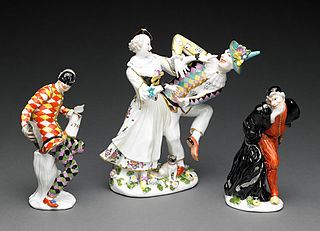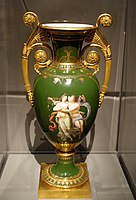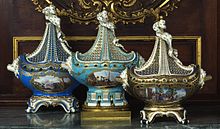
Porcelain is a ceramic material made by heating raw materials, generally including kaolinite, in a kiln to temperatures between 1,200 and 1,400 °C. The greater strength and translucence of porcelain, relative to other types of pottery, arise mainly from vitrification and the formation of the mineral mullite within the body at these high temperatures. End applications include tableware, decorative ware such as figurines, and products in technology and industry such as electrical insulators and laboratory ware.

The Vincennes porcelain manufactory was established in 1740 in the disused royal Château de Vincennes, in Vincennes, east of Paris, which was from the start the main market for its wares.

Kakiemon is a style of Japanese porcelain, with overglaze decoration called "enameled" ceramics. It was originally produced at the factories around Arita, in Japan's Hizen province from the Edo period's mid-17th century onwards. The style shares much in common with the Chinese "Famille Verte" style. The quality of its decoration was highly prized in the West and widely imitated by major European porcelain manufacturers during the Rococo period.

Soft-paste porcelain is a type of ceramic material in pottery, usually accepted as a type of porcelain. It is weaker than "true" hard-paste porcelain, and does not require either the high firing temperatures or the special mineral ingredients needed for that. There are many types, using a range of materials. The material originated in the attempts by many European potters to replicate hard-paste Chinese export porcelain, especially in the 18th century, and the best versions match hard-paste in whiteness and translucency, but not in strength. But the look and feel of the material can be highly attractive, and it can take painted decoration very well.

Biscuit porcelain, bisque porcelain or bisque is unglazed, white porcelain treated as a final product, with a matte appearance and texture to the touch. It has been widely used in European pottery, mainly for sculptural and decorative objects that are not tableware and so do not need a glaze for protection.

In pottery hausmaler is a term for the artist, the style, and the pieces in hausmalerei, the process of buying pieces of pottery as plain "blanks", and then painting them in small workshops, or the homes of painters, before a final firing. In European pottery of the 17th to 19th centuries this was at certain times and places a significant part of production, and the decoration could be of very high quality. In England this was referred to as "outside decoration" and was also very important in the 18th and early 19th century, with some revival in the 20th.

Meissen porcelain or Meissen china was the first European hard-paste porcelain. Early experiments were done in 1708 by Ehrenfried Walther von Tschirnhaus. After his death that October, Johann Friedrich Böttger continued von Tschirnhaus's work and brought this type of porcelain to the market, financed by Augustus the Strong, King of Poland and Elector of Saxony. The production of porcelain in the royal factory at Meissen, near Dresden, started in 1710 and attracted artists and artisans to establish, arguably, the most famous porcelain manufacturer known throughout the world. Its signature logo, the crossed swords, was introduced in 1720 to protect its production; the mark of the swords is reportedly one of the oldest trademarks in existence.


Mintons was a major company in Staffordshire pottery, "Europe's leading ceramic factory during the Victorian era", an independent business from 1793 to 1968. It was a leader in ceramic design, working in a number of different ceramic bodies, decorative techniques, and "a glorious pot-pourri of styles - Rococo shapes with Oriental motifs, Classical shapes with Medieval designs and Art Nouveau borders were among the many wonderful concoctions". As well as pottery vessels and sculptures, the firm was a leading manufacturer of tiles and other architectural ceramics, producing work for both the Houses of Parliament and United States Capitol.

Limoges porcelain is hard-paste porcelain produced by factories in and around the city of Limoges, France, beginning in the late 18th century, by any manufacturer. By about 1830, Limoges, which was close to the areas where suitable clay was found, had replaced Paris as the main centre for private porcelain factories, although the state-owned Sèvres porcelain near Paris remained dominant at the very top of the market. Limoges has maintained this position to the present day.

Capodimonte porcelain is porcelain created by the Capodimonte porcelain manufactory, which operated in Naples, Italy, between 1743 and 1759. Capodimonte is the most outstanding factory for early Italian porcelain, the Doccia porcelain of Florence being the other main Italian factory. Capodimonte is most famous for its moulded figurines.

Saint-Cloud porcelain was a type of soft-paste porcelain produced in the French town of Saint-Cloud from the late 17th to the mid 18th century.

Art pottery is a term for pottery with artistic aspirations, made in relatively small quantities, mostly between about 1870 and 1930. Typically, sets of the usual tableware items are excluded from the term; instead the objects produced are mostly decorative vessels such as vases, jugs, bowls and the like which are sold singly. The term originated in the later 19th century, and is usually used only for pottery produced from that period onwards. It tends to be used for ceramics produced in factory conditions, but in relatively small quantities, using skilled workers, with at the least close supervision by a designer or some sort of artistic director. Studio pottery is a step up, supposed to be produced in even smaller quantities, with the hands-on participation of an artist-potter, who often performs all or most of the production stages. But the use of both terms can be elastic. Ceramic art is often a much wider term, covering all pottery that comes within the scope of art history, but "ceramic artist" is often used for hands-on artist potters in studio pottery.

Chantilly porcelain is French soft-paste porcelain produced between 1730 and 1800 by the manufactory of Chantilly in Oise, France. The wares are usually divided into three periods, 1730-51, 1751-1760, and a gradual decline from 1760 to 1800.

Mennecy-Villeroy porcelain is a French soft-paste porcelain from the manufactory established under the patronage of Louis-François-Anne de Neufville, duc de Villeroy (1695–1766) and — from 1748 — housed in outbuildings in the park of his château de Villeroy, and in the nearby village of Mennecy (Île-de-France). The history of the factory remains somewhat unclear, but it is typically regarded as producing between about 1738 and 1765.

The city of Rouen, Normandy has been a centre for the production of faience or tin-glazed earthenware pottery, since at least the 1540s. Unlike Nevers faience, where the earliest potters were immigrants from Italy, who at first continued to make wares in Italian maiolica styles with Italian methods, Rouen faience was essentially French in inspiration, though later influenced by East Asian porcelain. As at Nevers, a number of styles were developed and several were made at the same periods.

Rouen porcelain is soft-paste porcelain made in the city of Rouen, Normandy, France, during a brief period from about 1673 to 1696. It was the earliest French porcelain, but was probably never made on a commercial basis; only nine pieces are now thought to survive.
The Limoges Box is type of small hinged porcelain trinket box produced by Limoges porcelain factories near the city of Limoges, France. They are made of hard-paste porcelain and collected worldwide.

Pot pourri à vaisseau or pot pourri en navire is the shape used for a number of pot-pourri vases in the form of masted ships, first produced between the late 1750s to the early 1760s by the Sèvres manufactory near Paris. The colours and details of the painted decoration vary between examples, as is typical of Sèvres porcelain, and one example is on a later gilt wood stand. The openwork lid lifts off to allow refilling of the pot-pourri. The shape was eventually produced in two or three versions, at slightly different sizes. It was first designed in 1757, probably by Jean-Claude Duplessis, the artistic director of the factory. The first surviving finished example dates to 1759. Another name for them is vaisseau à mat.

China painting, or porcelain painting, is the decoration of glazed porcelain objects such as plates, bowls, vases or statues. The body of the object may be hard-paste porcelain, developed in China in the 7th or 8th century, or soft-paste porcelain, developed in 18th-century Europe. The broader term ceramic painting includes painted decoration on lead-glazed earthenware such as creamware or tin-glazed pottery such as maiolica or faience.














































